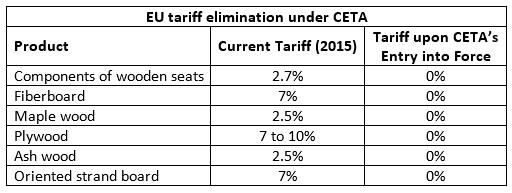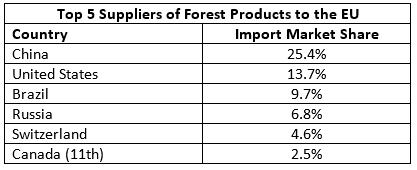While most Canadian forest products already enter the EU duty-free, upon CETA’s entry into force, all Canadian forestry products will enjoy duty-free, quota-free market access to the EU. Current EU tariffs for forest products range from 2% to 10%. The EU is the world’s third largest importer of forest products – $46 billion in 2015 or 14% of global forest product imports in 2015. Canada’s advantage includes areas where EU demand is strong. Key exports from Canada, such as wood pellets, sawn/sliced coniferous wood, chemical wood pulp of coniferous wood, and seat components, have strong demand in the EU.

Canadian companies can benefit from provisions in CETA related to regulatory cooperation, government procurement, temporary entry, and trade in services. Canada will have a preferential trade advantage with the EU that many competitors will not have.

According to Statistics Canada, the main European markets for Canadian softwood lumber in 2015 were UK with 56 thousand cubic meters, Belgium – 64 thousand cubic meters, France – 12 thousand cubic meters. The supplies to EU very small in comparison with export to USA (31 million cubic meters), China (6.5 million cubic meters) and Japan (2.3 million cubic meters).
In 2015 Canada has exported 1.2 million tonnes of wooden pellets to UK, 85.5 thousand tonnes to Italy and 14 thousand tonnes to Austria.

